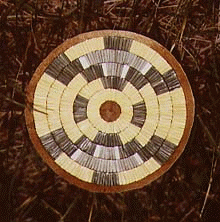 |
The Parallel or Band Technique contributed by Nancy Fonicello |
| Quilled Rosette made by Nancy using the Single-quill Parallel-fold or Band Technique. |
 |
The Parallel or Band Technique contributed by Nancy Fonicello |
| Quilled Rosette made by Nancy using the Single-quill Parallel-fold or Band Technique. |
The single band technique is another type of quillwork technique that is easily mastered. It is similar to the zig-zag technique except for the fact that the quills on the top row are folded away from you rather than toward you. This technique is also is the foundation for more advanced quillwork stitches, including the multiquill plaiting and single line work. And by the way, I did not originate the method of twisting quills with the thread as described below. The first reference I ever found to it was in Jean Heinbuch's book "A Quillwork Companion", for which I am very grateful.
And if you are just beginning, you may want to take a look at the discussion of tools and materials:
|
Tools and Materials |
Sewing Techniques
As in the zig-zag technique, prepare your quills by snipping off both
ends and soaking the quills in water to soften them. Again draw two lines on your leather
where you want the embroidery to be. The distance between the lines will be
determined by the design, but keep in mind that this type of quillwork tends to
be a little more fragile than the zig-zag stitch, and keeping the lines 1/4" to 3/8" apart
will help keep the work tight to the leather and less likely to get caught on something
and tear out when your work is done.
Variations on the Parallel Band Technique
As mentioned above, the parallel band technique is the basis for some of the
more complicated quillwork stitches, such as multiquill plaiting. The only difference
here is that you are working with 10 or more quills at a time instead of one. The stitching
techniques are exactly the same. You will also find that the band technique lends itself well to
small intricate designs and curving patterns such as pictoral and rosette work.
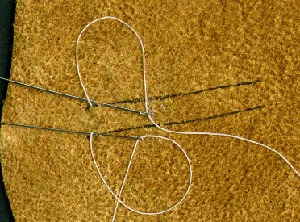
Again knot the thread on top of the work
by taking a few close stitches on top of the leather.
Bring the threads up to the beginning of your
line where you want your first quill to be. Do this for both
top and bottom lines. This picture shows both needles in position ready to
take a back stitch (for more information on the back stitch see the diagram
under Zig-Zag Technique
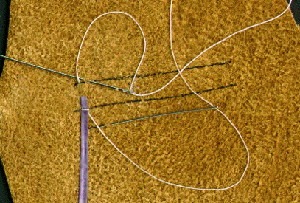
Flatten the quill and insert one end under the stitch on the bottom line.
Pull the stitch tight to hold the quill in place. Remember to be sure that
your quill is very flat and has no wrinkles in it, as these are difficult to
remove later.
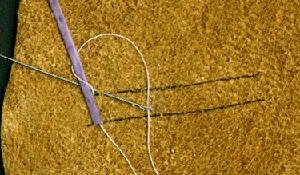
Now comes the tricky part! Bend the quill up towards the top line as you would in the
zig-zag technique, but instead of just taking a straight stitch across the quill as before, this
time loop the thread around the quill as shown. As you pull the thread tight, the quill will flip
away from you and point down towards the bottom line. Adjust the fold by pulling the thread and the quill opposite one another (gently!) so that the fold sits on the drawn line. You should now have something that looks like the following picture.
An alternative way of bending the quill is by folding it over the needle before you take the stitch.
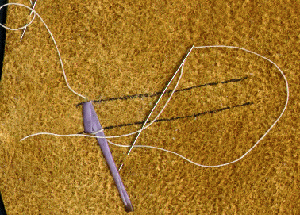
Take another stitch across the quill with the bottom thread. Remember, the bottom stitch is just a
simple straight back stitch. Only the top line in this technique requires the twisting thread loop.
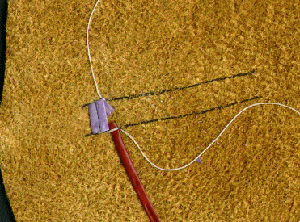
Continue on in this manner until you come to the end of the quill. Unlike the zig-zag technique, there is no need to end the quill at the bottom. Snip off any remaining quill after you have made your last stitch on the top line. To start a new quill, take a new stitch in the bottom line and work it the same way as you did before
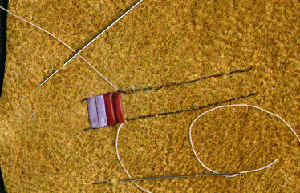
Continue
along adding quills as you go. Occasionally stop and run your
tablespoon across the top of your work, adding a little pressure
to help flatten it. When you get to the end of your row, simply
tuck the last little quill end under the work.
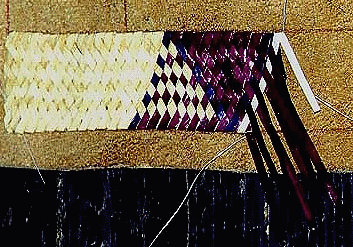
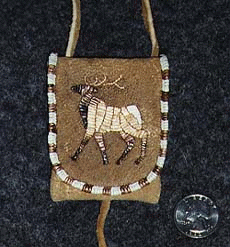
using the Band Technique and all natural dyes
Return to NativeTech's Main Porcupine Quillwork Menu

|
Text and Graphics
© 1994 - Tara Prindle unless otherwise cited. |